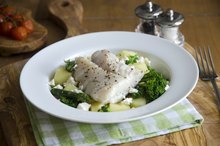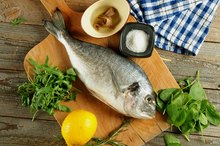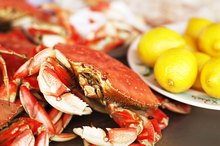Lobster Nutrition Information
If you eat your lobster dripping with butter, it isn't all that healthy, but if you forgo the butter, you can enjoy this delicious type of seafood in moderation. It is relatively high in cholesterol and sodium and a source of mercury, so you shouldn't eat it every day. Even pregnant women, however, can safely consume up to 36 ounces of lobster per month since it is one of the lower-mercury seafood options.
Lobster Lowdown
Lobster is low in both fat and calories while providing significant amounts of protein. Eating 3 ounces of cooked lobster will give you just 76 calories, along with 16.2 grams of protein and 0.7 grams of fat. This is 32 percent of the daily value for protein and 1 percent of the daily value (DV) for fat.
Micronutrient Makeup
Baked Haddock Nutritional Values
Learn More
A 3-ounce serving of lobster is an excellent source of zinc, copper, selenium and vitamin B-12. You need copper for forming red blood cells, selenium for limiting cell damage from harmful compounds called free radicals, and vitamin B-12 for forming DNA. The same serving of lobster is a good source of phosphorus, too, providing 16 percent of the DV. Phosphorus is important for forming strong bones, and zinc helps with immune function.
Essential Fat Estimate
Your body can't produce the essential omega-3 fats, making it important for you to get them in your diet. Meeting the Academy of Nutrition and Dietetics' recommended intake of 500 milligrams per day of a combination of eicosapentaenoic acid (EPA) and docosahexaenoic acid (DHA) can help lower your risk for heart disease. While not one of the types of seafood highest in omega-3 fats, each 3-ounce serving does contain 165 milligrams of EPA plus DHA.
Cholesterol Considerations
Nutrition Facts for Anchovy Fillets in Oil
Learn More
High blood cholesterol levels increase your risk for heart disease. While saturated fat is the main dietary culprit when it comes to high cholesterol, dietary cholesterol can make a difference as well. If you consume lobster, you'll have to limit your other cholesterol sources for the rest of the day since it provides 124 milligrams per serving, or about 41 percent of the DV.
Sodium Situation
Another potential drawback to consuming lobster is the amount of sodium it contains. Each serving provides 413 milligrams, or about 18 percent of the recommended limit of 2,300 milligrams per day for healthy people and 28 percent of the recommended 1,500-milligram limit for people with high blood pressure. Consuming too much sodium can increase your risk for high blood pressure and heart disease.
Related Articles
References
Writer Bio
Based in Massachusetts, Jessica Bruso has been writing since 2008. She holds a master of science degree in food policy and applied nutrition and a bachelor of arts degree in international relations, both from Tufts University.









